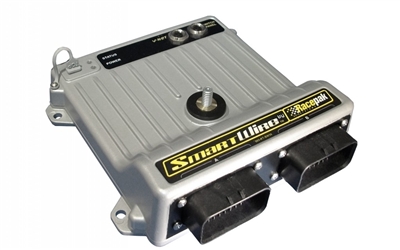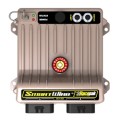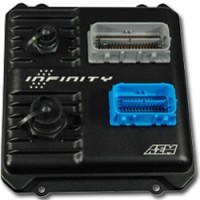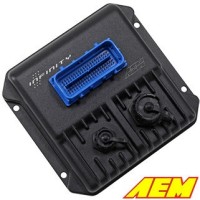Product Description
TECHNICAL SPECIFICATIONS
| Output Capacity: | 125 Amps |
| Current Consumption: | 180 mA typical operation (<1 mA in shutdown mode) |
| Min/Max Power Supply: | 8-20 Volts |
| Operating Power Supply: | 12-16 volt automotive applications |
| Inputs: | 12 hardwired direct (voltage triggered (>2.7V) or ground triggered (<2.5V) |
| Outputs: | 30 (8 outputs @ 20 Amps, 22 outputs @ 10Amps) |
| Response: | 3.0 milliseconds max |
| Programming: | USB (or via V-Net when used with a V-Net data recorder) |
| Dimensions: | Length 6.5” (16.51 cm), Width 5.5” (13.97 cm), Height 2.0” (5.08 cm) |
| Weight: | 25.8 ounces (731.4 grams) |
| Note: All current ratings are for 12 volt operation. For 16 volt systems you must subtract 25 percent. | |
WHAT IS A RACEPAK SMARTWIRE POWER DISTRIBUTION MODULE?
One of the really powerful aspects of power distribution modules is the ability to monitor in real-time any of the circuits that are connected to it.
I’ve got a circuit here set up, just so we can have a look at as an example, which is a fan circuit. You can see here, we can monitor in real-time by the current and the voltage of that particular channel. Now, if I turn the circuit on, you can see that when we first turn it on, the current peaks up at around about 11 or 12 amps. As soon as the motor gets up to speed, the current drops right back to a holding current of around about four or five amps. Now that’s pretty common for most DC model outputs, so that’s what we’d see on a radiator fan or maybe a gearbox pump or even a fuel pump.
Now what we can do is, with this particular channel or any channel on the power distribution module, we can set a fusing current. At the moment, you can see we’ve got that fusing current set at 20 amps, and we never got anywhere close to that. Just for an example, what we’re going to do is we’re going to set that down to about just three amps, and we’re going to send that configuration through to the power distribution module. Okay, now we’re done there, if we bring up our real-time display, we’ll start that fan up again and we’ll see what happens. Now you can see that as soon as it starts up it draws quite a lot of current. It runs for a little while and then we get a fuse blown status. Now if you can see what’s happening here though, this is one of the really powerful aspects of the power distribution module.
With the conventional wiring configuration of your normal fuses in relays, as soon as that fuse blows, you’ve got to stop. You’ve actually got to get out of the car and replace the fuse. It’s a physical fuse. Once it’s blown, that’s it. With the power distribution module, you can actually set the power distribution module up to retry that particular circuit. Perhaps there’s a really particular set of circumstances, your battery voltage is really low, and that just produces enough current to trip out the fuse. Okay, so what we can do is have it retry that circuit so it’ll wait for, in this case, one second, and then it will retry the circuit. We can set up how many times it will retry. In this example here, it will retry 100 times. If it keeps retrying for 100 times, that’s 100 seconds, it keeps blowing the fuse. At that point, the power distribution module says, “Okay, there’s obviously a real problem here. We’re going to quit it. We’re not going to try any more.” That’s where the real power of these modules comes in.
Now if we look at another example, I’ve got a circuit set up here that I’ve just got 12 volts coming out of. What we’re going to do is have a look at that particular circuit live. We can see here we’ve got it set up with a fusing current of ten amps. If you watch the current here and the voltage in real-time, the circuits on at the moment, but we’ve got the circuit hooked up to nothing. Now if I just grab that wire and I short it out just on the roll cage here, what you’ll see is the current spikes up and straight away we’ll see that fuse blows. Okay, so if we get a really high level of current instantaneously, the power distribution module will disconnect that circuit straight away. It’s very, very safe, very, very easy to configure, and totally configurable by the end-user to suit whatever circuits you have hooked up to your race car.







Reviews
There are no reviews yet.